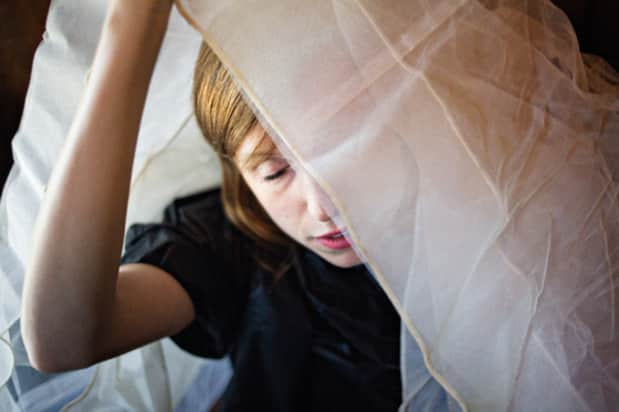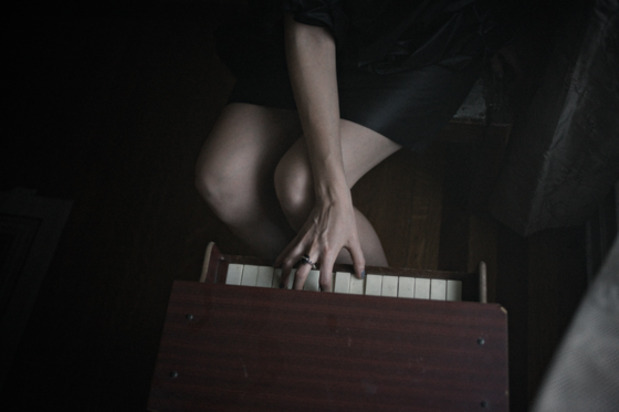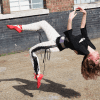Hung in a gigantic sky lit room at Dia Beacon, an art museum an hour and a half north of New York City, is a series of paintings by Andy Warhol called “Shadows.” Warhol completed the 102 abstract canvases—a repetition of blurry figures in various densities and colors—in 1979, and asked that they always be displayed as one piece. It is rumored that the shadows in question were either cast by pieces of paper ripped and held to light by Warhol’s longtime assistant, or they are erect penises held probably less close to light by who knows. You can ponder yourself silly about the whats, whys and hows of the art world in Warhol’s room at the Dia—they’ve put out two comfy couches in the middle of the room for relaxed contemplation. Which is exactly what I thought Cameron Mesirow would do, but instead, jetlagged out of her mind, she sinks into the cushions and pretends to snore. But unwilling or unable to actually sleep, Mesirow opens her eyes and says what she’s been thinking about, which turns out is her middle school Spanish teacher, Señor Duffy. He hated gum. One day, she says, he came into the class wearing a Western-style shirt with snap buttons, unusual. When he heard the inevitable chewing, he ripped open the shirt to reveal a secret undershirt that read in big print chicle en la basura—gum in the trash! Mesirow laughs and we get off the couch and head to the room with dirt and broken glass on the floor. She loves it.
It’s pretty much Mesirow’s birthright to love weird shit. Her father is a musician who now lives in Germany and performs with the Blue Man Group. Her mother was a singer in the almost famous late ’70s Boston new wave band Human Sexual Response. Their most famous song, “Jackie Onassis,” was quoted by Rage Against the Machine. Their second most famous is “Butt Fuck.” In the group with Mesirow’s mother were Dini Lamot and Windle Davis, who, 30 years later, are still a couple. After the band broke up in 1980, Lamot and Davis shifted their creative energy towards home restoration, buying and rehabbing rundown properties. Their current project is The Inn at Hudson, a big brick bed and breakfast in upstate New York. After we wander through the rest of Dia (Mesirow on Richard Sera: “I feel the bigness”) and eat a lot of French fries from a paper bag, we hop in the car and drive an hour east to the Inn. Mesirow sleeps the entire way.
Davis and Lamot leave a key in the mailbox, so we let ourselves in, even though it turns out they’re home. They’re running late for a birthday dinner in town, but find a minute to fawn over Mesirow and give a brief tour, the highlight of which is an unbloomed, tubular fl ower marked with a “do not touch” sign and watched by a camera intermittently capturing the bloom’s buildup. When it opens, Lamot says gleefully, it will smell like trash.
We divvy up rooms and Mesirow chooses the Pink Room, largely based on the giant bathtub. The Green Room also has a tub, but it’s a little smaller, and is without a companion television. The White Room has a four-poster bed and pillows soft enough that they may be stuffed with the fur of a thousand baby rabbits. And looking around the house, it’s possible they are. There are creepy puppets, statues of lions, a grand piano and a toy piano, risqué photography books, gargoyles and generally anything that one might call an antique. Mesirow points out little details like a proud parent.
After eating a well-deserved meal and downing an espresso, Mesirow nuzzles up in a Persian rug-patterned easy chair and, with the stink flower’s camera flash going off every 30 seconds, finally unfurls.
“Where do I belong?” she asks. “Glasser doesn’t feel like it’s part of a time or something. It’s just…I don’t know.” It’s been three years since she began making music as Glasser and it’s three months before her debut album, Ring, is released. A fairly gigantic undertaking, Ring blends Mesirow’s considerable talents as a singer with her penchant for broad, odd and beautiful instrumentation. Beginning as a bedroom project, with Mesirow sitting on the edge of her bed singing into her computer, Glasser’s foundation is still similarly simple, but she’s allowed the details to blossom vividly. Where she once used her laptop’s stock sounds, Ring replicates in real life with marimbas, chimes, saxophone, koto and an array of heavy drums and synthesizers. Mesirow boasts that it contains “not a lick of guitar.” It’s unclear if this is true. Though fully strange, Ring is undeniably a pop record, Mesirow’s gorgeous and supple voice often doubled, ooh-ing underneath subtle, interlocking harmonies. There is something in my mind/ Keeps me up all night, she sings in “Apply.” And though she’s most likely talking about the mechanics of sleep, you’re free to hear it as a love song. But, “Apply,” like the rest of Ring, sits askew from more common verse-chorus-verse songs, somewhere between the repetitive minimal composition of ’60s hippies like Steve Reich and Terry Riley and the obsession with juxtaposition of futuristic rap producers like Bangladesh. Mesirow says she often finds herself compared to Björk. “Fair enough,” she says. “It’s a loud woman’s voice with electronic music and funny outfits.” She says this while wearing a dress a space princess would wear to a party in a black hole.
Mesirow says she often finds herself compared to Björk. “Fair enough,” she says. “It’s a loud woman’s voice with electronic music and funny outfits.” She says this while wearing a dress a space princess would wear to a party in a black hole.
Ring’s centerpiece and most intense song is “T,” which is what Mesirow calls Tauba Auerbach, her best friend of 10 years. They met growing up in California, going to hardcore shows, and have stayed telepathically close even after Auerbach moved to New York in 2008 and her art career began to flourish. “We don’t exactly look alike, but recently someone who knows me really well but had never met Cameron spotted her in a room and thought, ‘That girl really reminds me of Tauba,’” says Auerbach. “He had no idea he was detecting something real.” In fall of 2009, as part of a solo show at Deitch Projects, which included Auerbach’s massive paintings of folded paper and close-up photos of television static, Auerbach and Mesirow collaborated on the Auerglass, a massive two-person air pump organ they designed and had custom built. “I usually work alone and shy away from collaboration, but Auerglass is different,” says Auerbach. “It came about naturally, through a several-years-long ping pong of ideas that lead us to something we just sort of had to realize. It seemed worth the risk of a hard collaboration.” Daily, for the duration of the exhibit, Mesirow and Auerbach sat at each end of the organ, playing a piece Mesirow composed. The Auerglass must be played in tandem, as each player’s foot pedals directs air into the other player’s organ, making it impossible to perform alone. As part of the performance, Mesirow had another friend, Ida Falck, design something between a costume and functional apparatus for her and Auerbach—voluminous dresses and notched wooden shoes. When the two of them stood back to back and lined up their heels, they clicked in place as one unit.
Though their aural and visual mediums are fundamentally different, Mesirow and Auerbach’s skewed views on each are similar. When Auerbach draws pixelated computer static with colorful acrylics on a giant piece of paper, it’s the same pleasant deconstruction of form as Glasser’s reworking of the heart of pop. They’re two parallel, happy scientists whose relationship exists outside the bonds of familial or romantic love and complication. “The affection that I feel for Tauba doesn’t need to keep time, I don’t have to keep evaluating if I love her,” says Mesirow. “When I met her, I didn’t know I was going to love her forever. But now I know.”
“T,” which Mesirow calls “a real love song,” is the spiritual and literal center of Ring. Track five of nine, it is the only one without a partner. “Eight of the nine songs are paired up and they share themes,” she says. “‘Home’ is the second song on the record and ‘Treasury of We’ is the eighth song, and they share a disorientating factor. They’re both about false stability.” All of Mesirow’s songs are heavily influenced by the sluice of dreams and, in addition to creating couples on Ring with the songs, she’s envisioned the act of listening to the album as never starting and never ending. “It’s a recurring thing in my life that I have really intense dreams. I’ve had periods of time when it has profoundly affected my waking life because I’d be so haunted by a dream. So, I thought, wouldn’t it be amazing if I could make something that really felt like, or really added to, or spoke to that world,” Mesirow says. “So often in your dreams you don’t know where you are, or you do know where you are, but it doesn’t look like it. Like I’m at the Inn at Hudson, but it doesn’t look like the Inn at Hudson, but I know that’s where I am. It’s such a mental state. And so abstract, and we’re so often in our dreams trying to discover things, or discovering things, and I think I wanted to do something that confused slightly. If you had a record that you could start at any one point and it would lead back to that point, you wouldn’t ever really have to start it at the same place.” So, with the help of Swedish producers Van Rivers and The Subliminal Kid, Mesirow created interstitials between all of the songs so that it can play on a continuous loop. “I guess I just thought about making something that wasn’t as straight forward as beginning-middle-end, because that’s kind of how it is in your dreams.” A bit after midnight, Mesirow hikes up the stairs to sleep.
"I have really intense dreams. I've had periods of time when it has profoundly affected my waking life because I'd be so haunted by a dream."
In the morning, after a bath, Mesirow comes down to a breakfast of fruit, which she says she eats every morning to maintain her digestion. While eating, she spends a good couple of minutes happily talking about her bowels. It’s unclear if this is the strangest conversation I’ve ever had or the most normal. Confusing this further is the fact that Mesirow is wearing a dress that basically looks like a charcoal trash bag with a fluffy turtleneck. Lamot, an excellent cook, comes out of the kitchen, green apron over his Hawaiian shirt, and tells her how much he adores it. They begin speaking the secret language of people who’ve known each other literally forever, and then, falling into nostalgia, they show me the “Hairinary,” a construction paper and markers dictionary of haircuts Mesirow, her mother, Lamot and Davis made when Mesirow was seven. Then they play “Tales of Disneyland,” a song Lamot, Mesirow and her father recorded when she was 12. We put water balloons in our bras, she sings on it, and both she and Lamot now sing along, Mesirow absentmindedly playing with the stuffed chicken dog toy on her lap. Lamot gladly burns me a CD copy, but not before performing a number from his second career as busty drag queen Musty Chiffon. He does it in street clothes because Musty’s wig is wet on the table. While he’s singing, some guy wanders in the back door, sits down and eats a sandwich. “You got a real taste of my childhood,” Mesirow says and we say our goodbyes and go back to the city.
When we meet two days later, Mesirow says she’s spent the whole day looking for a sublet. Even though she talks like a California girl, saying “stoked” all the time, and even though she’s lived on the West Coast since she was seven, almost 20 years now, and even though her dad has lived in Germany a decade, she’s East Coast at heart. She was born in Boston and now she’s moving to New York. Right now she’s crashing at Auerbach’s too tiny apartment, so she’s spent the day exploring the cheaper nooks of Williamsburg, searching for a room. She hasn’t had a lot of luck. When she arrives, she’s frustrated and hot from running around in gross New York summer. So we go get something to eat.
Number 7 is the Glasser of restaurants. A convivial corner spot in Fort Greene, it’s the kind of place where they fry whole heads of broccoli and your bread comes with an anonymous bean puree they keep warm in a crock pot by the register. Because or in spite of this hybrid futurism, everything’s delicious. Mesirow loves it, gets a dry white wine and the mahi-mahi, which she says is the steak of fish. Our conversation is more Cameron than Glasser. She’s never very Glasser. Though she tries to be diligent when discussing the extrication of Glasser from her brain’s murk of poor sleep and strange dreams, she’s much more comfortable, and much better, at making regular chitchat. She’s extremely polite and very charming and as much as she clearly wants to succeed, her desire to be amiable may be just as strong. “I just want the people around me to feel comfortable,” she says. “It’s just hard to say this kind of stuff .” She uses Glasser to say some of it. Who knows if it makes her a better artist. It certainly makes her a nicer person.
After we get the check, we buy a small plastic tub of Swedish fish and park it on a stoop. Mesirow explains why her mother no longer sings, her ideas about dreams. We pause to discuss if it’s too buggy, if we should move inside. We stay outside. Mesirow eats some candy and justifies her perennial problems with soundmen. We decide it’s too buggy and move inside. Mesirow pees because, she says, she’s had a lot of liquids. It sounds like a sensible thing aging adults say before they suck it up and get a prescription to stop peeing so much. Mesirow settles on the couch, declines more wine and we keep talking.
Why is Glasser so weird when you aren’t? I ask. She tries to answer, brings up the directness of singing, her occasional martyr tendencies. Then she gives up. “Maybe the story is that I’m not that weird,” she says. I don’t know, I say. “I don’t know, either,” she says.





